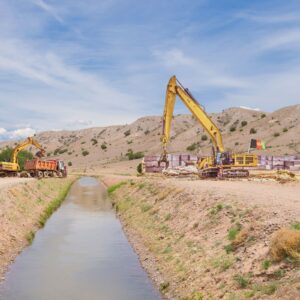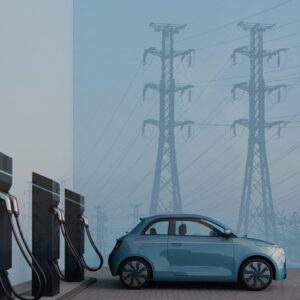Solar Water Pumps As Sustainable Solutions in Water and Power Distressed Communities
The summer of 2014 took me back to my ancestral village in central Punjab, Pakistan where my team of student volunteers and I installed a solar powered water pump in response to a severe water shortage, which had been exacerbated due to nationwide electricity shortfalls. The pump provides clean drinking water daily to roughly 1000 of the town’s 1,500 residents, and it has had a dramatic impact on the village’s economic and societal well-being.
I had witnessed very closely the turn of fortunes for Jurr’s community. Almost a decade ago, the water table in the district dropped, and hand-pumped water wells (which villagers relied on for their daily consumption and for crop irrigation) began to dry up. When all was well and water plentiful, this little town of mud houses and brick kilns saw a growing population, an improving literacy rate, an expanding economy built on vast fields of wheat and barley, and widely circulated fresh produce from animal rearing, such as milk and ghee (a native variation of clarified butter). However, with the gradual exhaustion of these water sources, the sight of women carrying matkas (brick buckets) from a well 5 miles away replaced the sights of business as usual. School enrollment rates dropped as children helped mothers carry home the water or worked fields for additional income, and most animals were either sold off or died as families struggled to fulfill their own hydration needs, let alone those of their animals. Economic growth and social mobility came to a sudden standstill.
To see the very blueprints of an otherwise harmonious and peaceful community drastically altered in the face of this water shortage fundamentally challenged my understanding of conflict and peace. It was apparent that these two terms did not have to be privatives, negatively defined as the absence the other. Surely no reasonable understanding of peace could be envisioned in a water scarce community without fulfillment of this fundamental necessity. Similarly, conflict in Jurr did not have to entail violence. In fact, it seemed better defined as a poignant clash of long-term and immediate priorities: a child’s education versus the fundamental daily need for hydration for instance.
This proposal to re-asses our understanding of peace and conflict in under-resourced communities received encouragement from the Kathryn Davis Foundation, which supports conflict-resolution projects the world over. The summer of 2014, I was awarded $10,000 as part of the Davis Projects for Peace to further this hypothesis, and my team and I installed a solar powered water pump in the village as a sustainable solution to Jurr’s decade-long struggle with water.
The construction of the solar water pump was fairly straightforward: a local contractor helped drill 300 feet underground (ten times deeper than the earlier hand pumped wells, which only reach 30 feet), ensuring that we channel water from significantly deeper underground, and hence tap an enduring water source unhindered by any further minor drops in the water table. The bore is lined with concrete and water filters, and a motor is placed at the pit of the well. Solar panels power this submerged pump by way of an inverter that converts DC (direct current) from the sun to AC (alternating current). An attached battery stores enough power for post-sunset operation, and the pumped water sits in a 1000-gallon water tank in the center of the village.
The system guarantees roughly 15 liters each of safe, drinking water to around a 1000 people on a daily basis, plenty for both their daily consumption (the daily recommended intake for adults is 3.7 liters a day), cooking, and personal hygiene.
In the short run, the pump ensures an immediate supply of clean drinking water that is unaffected by financial constraints (since the water is available free of cost) or governmental inefficiencies (as the pump is truly independent and does not, for instance, rely on the state-owned the electricity grid). The pump releases the villagers from a worry that has occupied an entire generation’s mental processes. It ensures that a laborer has their 15 recommended cups of water each day and that women do not have to make long treks to faraway water wells. It ensures a healthier community not only via an adequate supply of water but also by reducing the chances of water-related diseases such as malaria, since locals no longer need to store water for long periods in open tanks.
In the long run, this water pump will allow the locals to use the time and resources released from this commitment to better, more productive effects. For example, it allows a farmer more time and energy for cultivating and nurturing crops. It allows parents to spend more time thinking about their children’s wellbeing and education, and it allows the students to focus on their studies uninterrupted by thirst.
The night of inauguration, right before I left, Asim, a farmer and father of three, pulled me aside and expressed how, for him, access to water was not just about the fulfilling his thirst, about the schooling or even the long trek to distant wells, but instead about a sense of comfort and ease of a kind he had not known during the years where the search for water occupied his thoughts the entire day. Asim added, “I feel unburdened… the pump has let Jurr and its loving people start loving each other again and participating in each other’s sadness and happiness – after a decade, Jurr finally seems to be coming back to life.”
In order to further this sense of ownership among the locals, we organized a council of the local caretakers composed of those like Asim, who are directly invested in its upkeep. In addition to ensuring smooth operation, this close interaction with community representatives aids in establishing a broadened level of mutual trust. As this bond deepens we hope to begin advocating for other vital causes including better educational opportunities for girls, and youth enfranchisement via entrepreneurship. In that, the impact of the project could extend well beyond water provision to a more wholesome and interactive empowerment of the community.
We are currently running a campaign to fund a second solar-powered water pump, and hope to build upon these successes to bring this sustainable, green and efficient solution to other regions across Pakistan (and with some help, other countries). The World Health Organization and UNICEF estimate that 663 million people (one in ten people on the planet) still lack access to clean water, and it is our sincere hope and conviction that solar-powered water provision can serve as an effective tool in this battle against clean water scarcity.





